On this page:
About buildings in activity centres
Buildings in activity centres accommodate a wide range of uses, such as living, working, shopping and services.
Buildings in these locations may be larger than those in surrounding neighbourhoods, take up more of the site and be built to the front and side boundaries. They may incorporate a mix of uses that mean people are present at different times of the day.
Depending on the location within the activity centre, a building may be an intense development, it may provide a transition to more sensitive uses, or it may blend in with the surrounding area. Buildings in activity centres often accommodate a variety of uses and over time, these uses may change.
A building's design should consider future changes in use and internal layout.
Why is it important?
Buildings, together with the streets and public spaces, form the city. Buildings make a significant contribution to a city's sense of place, and its comfort and liveability.
The physical form and character of buildings shape the public spaces of a city. The activities buildings accommodate will have an effect on the surrounding area. Importantly, larger or complex buildings make a significant contribution to their setting.
Buildings in activity centres, whether private or public, contribute to the vitality of the street and public spaces.
5.1.1: ensure the building scale and form supports the context and preferred future character of the activity centre
In activity centres, buildings define the street spaces, focus views and provide a sense of enclosure for public spaces.
- Locate and shape the building to accommodate local topography and natural and cultural features of the site.
- Locate and shape the building to protect view corridors from streets and public spaces toward landmarks.
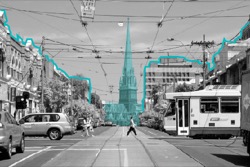
Tip: an important function of the public realm is to celebrate elements of value to the community. View corridors from streets and public spaces to significant landmarks, such as a memorial or a natural feature, are highly valued by the community. - Shape the building scale and form to support the existing character or the preferred future character of the area.
Tip: the building silhouette against the sky can make a significant contribution to the character of the area.
- Use the building height and setbacks to frame the street space as a public space.
Tip: building form and placement can effectively widen a narrow street or enclose a wide street. Refer to 2.2 Pedestrian priority streets.
- Where the street proportions and character are strongly defined, align the building frontage with existing front setbacks.
Tip: street character may also be defined by heritage buildings and landscape settings
- In retail and commercial mixed–use areas, place the building frontage on the front lot line.
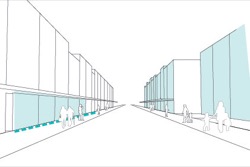
- Shape the building form and detail to reinforce important street corners.
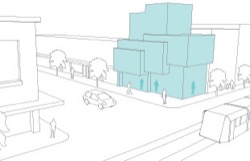
Tip: not all corners are important. A strategic planning process can identify important corners. - Set back upper levels of tall buildings or use a podium and tower form to create a pedestrian scale at street level.
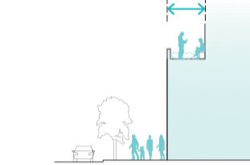
Tip: a podium with a tower set back from the street allows greater daylight access into the street and wider views of the sky and reduces wind turbulence at street level. A strategic planning process or built form analysis can identify appropriate street wall heights.
5.1.2: ensure the activity centre provides a graduated transition between different building scales and uses
- Provide a transition in scale from larger buildings to adjacent areas of smaller scale built form.
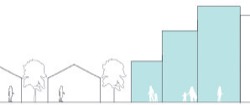
Tip: A larger building can transition to a lower scale neighbour by placing smaller scale buildings at the interface, or by stepping down the building towards the interface edge. - Define the boundary or transition between public space and private space without the need for high fences or barriers.
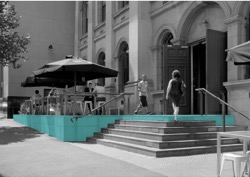
Tip: a slight change in building level can provide a boundary definition between public and private space.
5.1.3: ensure buildings in activity centres provide equitable access to daylight and sunlight
- Locate and arrange the building to allow daylight and winter sun access to key public spaces and key pedestrian street spaces.
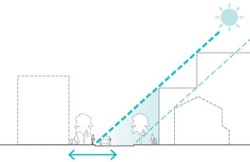
Tip: a strategic planning process can identify and establish key public spaces. - Allow sufficient distance between buildings to allow access to daylight for neighbouring windows.
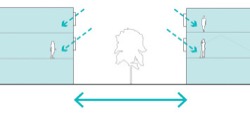
Tip: the higher the surrounding buildings the further they may need to be separated. - Protect daylight and sunlight access to the private and communal open space of adjacent dwellings.
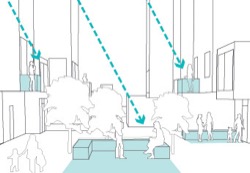
5.1.4: minimise adverse wind effects caused by buildings in activity centres
- Orient large buildings to minimise wind effects at street level and on adjoining properties and public spaces.
Tip: winds from a certain direction (such as the west) may be dominant, so avoid tall wall surfaces which would catch wind and cause down draughts.
- Detail the building façade to minimise wind effects on streets and public spaces.
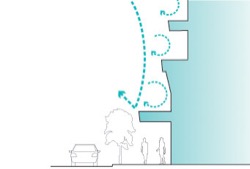
Tip: the shape and surface of a building can reduce wind turbulence at street level. Technical analysis of the wind and turbulence effects of tall buildings on adjacent public spaces can inform building design. - As part of a building’s design, install continuous weather protection for pedestrian priority streets and public spaces.
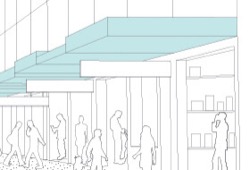
Tip: awnings provide protection from sun, wind and rain at street level. The Building Code of Australia sets out design standards for building projections beyond the street alignment. Where a building projection is over an Arterial Road Reserve, approval from VicRoads is required.
5.1.5: maximise safety through informal surveillance of streets and public spaces from within buildings in activity centres
- Arrange windows of buildings to overlook adjacent streets and public spaces.
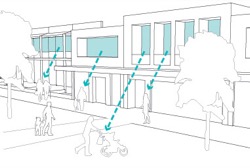
- Provide building entries and transparent windows to the street frontage.
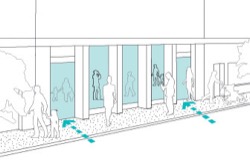
Tip: transparency need not be complete. Privacy and views need to be balanced and be appropriate to the building use. - Where security covering to windows is needed, install open–grill type shutters.
Tip: people prefer to walk along streets where there is activity, visual interest and a perception of being visible from nearby windows. People tend to avoid streets with long blank walls or solid security shutters that contribute no interest or activity at street level.
- Use low–height or semi–transparent front fences to assist informal surveillance of the street.
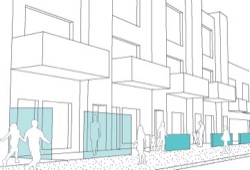
- Where front fences are more than one metre in height, provide a minimum of 50 per cent transparency.
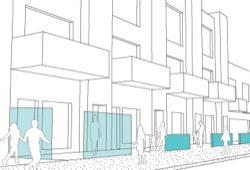
Tip: Front fences at street level that are low, open or partially transparent also create an impression of openness on the street. Where a fence is needed to minimise noise intrusion, consider using a solid, transparent material. - Limit wall recesses along the street edges of buildings to less than 300 mm deep to avoid their use as concealment place.
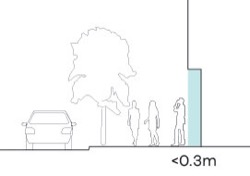
Tip: wall recesses deeper than 300 mm can provide potential hiding places. - In mixed–use buildings, provide a compatible mix of activities that attract people after business hours.
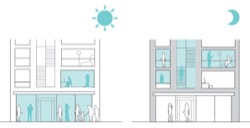
Tip: mixing uses in buildings, with retail and other commercial uses at street level, and residences on upper floors, provides activity during the day and evening.
5.1.6: ensure buildings in activity centres connect to the movement network
- Locate pedestrian entries to buildings on the pedestrian network.
Tip: entries should be clearly visible from footpaths along the street.
- Emphasise pedestrian entries with prominent design features, signage or landscape treatments.
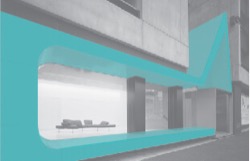
- Provide visitor bicycle parking near to pedestrian entries to buildings.
- Arrange vehicle entries to buildings to allow convenient, safe and efficient vehicle access to the street network.
Tip: reducing vehicle crossovers on footpaths, ensuring vehicles can enter and exit in a forward direction and having clear sight lines enhances both pedestrian and driver safety.
- Arrange vehicle entries to minimise the number of vehicle crossovers on pedestrian paths.
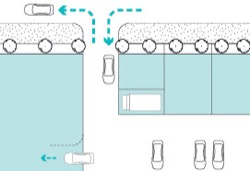
Tip: refer to 5.4 Car parking structures. - Locate vehicle and service access to the rear or side of the building.
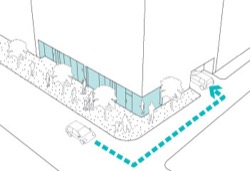
Tip: locating vehicle access away from the street frontage supports safe active pedestrian streets. Refer to 2.8 Car parking lots and 5.4 Car parking structures. - Separate the pedestrian entries from the vehicle entries to buildings.
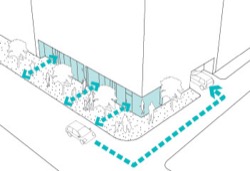
5.1.7: ensure the building facade detail supports the context or preferred future character of the activity centre
Larger buildings are more visible from the street and from a distance. Their facades can contribute to the character of the area and reinforce place identity.
- Arrange building elements such as roofs, balconies, windows, doorways and cladding materials to contribute to the preferred future character of the area.
Tip: an overall façade composition may use, for example, proportion, contrast, repetition, or alignment of the building elements to create an identity for the building.
- Where a building has a solid external wall facing a street or public place, detail the walls to provide an interesting appearance.
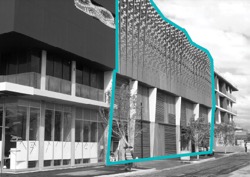
- Incorporate lighting of walls facing streets and public spaces to contribute to lighting of streets.
Tip: Wall lighting can also show off the building façade at night
- Shield from view or remotely locate mechanical plant, unless it forms an integral part of design
- Locate and arrange utility service installations to minimise their impact on the building’s active street frontage.
Tip: people prefer to walk along streets where there is activity, visual interest and a perception of being visible from nearby windows. People tend to avoid streets with long blank walls that contribute no interest or activity at street level.
5.1.8: achieve sustainable buildings in activity centres
- Use durable, sustainable and attractive materials that will minimise maintenance and contribute to the character of the area.
Tip: the use of specific materials should be based on local precedent or functional requirements.
- Adapt and re–use existing buildings, where practical.
- Lay out the building structure and internal spaces to allow future adaptation to other uses.
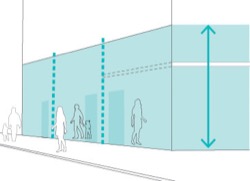
Tip: high ground floor ceiling heights and provision for multiple entry points support flexible re–use of a building. Car parks should also have ceiling heights and flat floors to facilitate future conversion to other uses. - Collect and use stormwater and recycled water for landscape irrigation, toilet flushing and cleaning.
Tip: water reuse systems need to be planned into a building at an early stage.
- Provide for efficient storage, separation and removal of waste and recycled materials from buildings.
Page last updated: 09/06/23